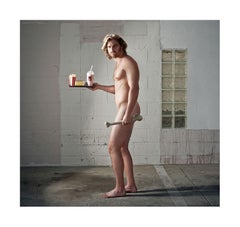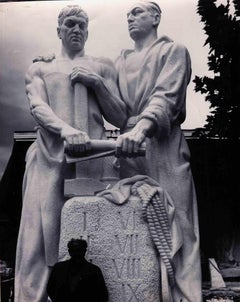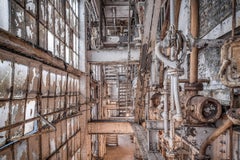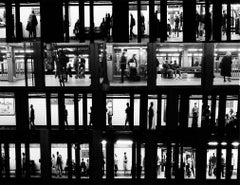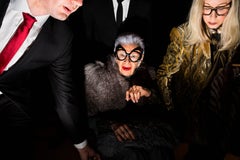Hammer Figurative Photography
to
1
1
1
1
Overall Width
to
Overall Height
to
1
3
3
1
3
1
31
13,859
7,176
5,747
3,945
3,180
2,529
1,907
1,868
1,690
1,492
1,374
1,316
1,305
1,022
957
926
911
898
848
2
1
1
2
1
3
Art Subject: Hammer
"Caveman" - Limited Edition Fine Art Print
Located in West Hollywood, CA
This entire series was inspired by a piece of graffiti by the street artist Banksy in the UK. Nick Stern - who ironically has been called the Banksy of Los Angeles and goes by the street name "Plastic Jesus" -decided to set himself the challenge to recreate the original Banksy...
Category
21st Century and Contemporary Street Art Figurative Photography
Materials
Archival Paper
Historical Photo - Union - Vintage Photo - mid-20th Century
Located in Roma, IT
Historical Photo -Union is a black and white vintage photo, realized in the mid-20th century.
Good conditions
It belongs to a historical album including historical moments, royal f...
Category
Mid-20th Century Contemporary Figurative Photography
Materials
Photographic Paper
Boiler House Windows
Located in New York, NY
40"x60" signed on reverse.
This photograph was taken at the site of Brooklyn's Domino Sugar Refinery, Paul Raphaelson's photographs chronicle the final state of the once bustling in...
Category
2010s Contemporary Figurative Photography
"Boiler House Windows" 27"x40" photograph of Brooklyn's Domino Sugar Refinery
Located in New York, NY
27"x 40" photograph, signed on reverse, unframed with certificate of authenticity.
This photograph was taken at the site of Brooklyn's Domino Sugar Refinery, Paul Raphaelson's photo...
Category
2010s Contemporary Figurative Photography
Related Items
NYC Subway Voyeur photograph (NY street photography)
Located in NEW YORK, NY
Fernando Natalici, "MTA Subway Voyeur" photograph, New York City, 2015:
An artful and secretly explorative composition of everyday city life by heralded NY underground photographer, ...
Category
21st Century and Contemporary Street Art Black and White Photography
Materials
Inkjet
Dries Van Noten (with Iris Apfel) - celebrity fashion photography
Located in Atlanta, GA
Described by New York Magazine's The Cut as their "backstage photographer extraordinaire," Nordeman was dispatched to photograph fashion weeks in New York, Milan, and Paris during Se...
Category
2010s Contemporary Figurative Photography
Materials
Photographic Paper
NYC Subway Voyeur photograph (NY street photography)
Located in NEW YORK, NY
Fernando Natalici, "MTA Subway Voyeur" photograph, New York City, 2015
An artful and secretly explorative composition of everyday city life by heralded NY underground photographer, Fernando Natalici. A window-like maze of ordinary everyday urban life turned something more...
Archival ink jet print on 310gsm paper.
Overall dimensions: 13 x 19 inches (image: 12 x 17 in.)
Hand-signed on the verso from a limited edition of 30 (+ 5 A/P's)
Obtained directly from artist. Seller is a primary dealer rep of Fernando Natalici.
About the artist
New York based photographer Fernando Natalici is best known for his iconographic documentation of the downtown Manhattan art scene of the mid/late 70's and early 80's. Natalici’s portfolio includes sought after images of a young Patti Smith, Blondie, Talking Heads, The Ramones and more. As an Art Director, Fernando has played a key role in creating memorable visuals for historic NY venues such as CBGB's, The Mudd Club, Area and Danceteria.
Fernando’s art design featured in the Jeffrey Deitch curated show “Area” at The Hole Gallery NYC in 2013, with his film stills from "Unmade Beds" & "The Foreigner"- two of the most significant underground films of the 1970’s New York Punk scene, exhibited at The Museum of The Moving Image in 2015.
Recent Publications
Twentieth-Century Boy: Notebooks of the Seventies by Duncan Hannah (2018)
'Showboat' by Toby Mott (2016)
Jim Jarmusch: Music, Words & Noise (2015)
Another Magazine (London, 2014)
Black Book (2014)
Curbed NY (2014)
'Area' by Eric and Jennifer Goode (2013)
Recent Exhibits
The Museum of The Moving Image (New York, 2015)
The Hole Gallery NYC (New York, 2014)
Lot 180 Gallery (New York, 2014)
Clic Gallery (New York, 2013)
Gallery 98 Bowery (New York 2013)
The Chelsea Hotel (New York 2012)
New York University Tisch School of The Arts (2013)
Related categories
Bruce Davidson. Walker Evans. Brassai. Street photography.
Category
21st Century and Contemporary Street Art Black and White Photography
Materials
Inkjet
NYC Subway Voyeur photograph (NY street photography)
Located in NEW YORK, NY
Fernando Natalici, "MTA Subway Voyeur" photograph, New York City, 2015:
An artful and secretly explorative composition of everyday city life by heralded NY underground photographer, ...
Category
21st Century and Contemporary Street Art Black and White Photography
Materials
Inkjet
The Girl In Union Square New York 1984 (New York street photograph)
Located in NEW YORK, NY
The Girl In Union Square by Fernando Natalici
Manhattan, 1984. The simplicity & grace of the anonymous passer-by rendered timeless by the snap of the camera. A window into a street photographer's decisive moment. A window into, not only the New York of 'then', but the beauty & chaos of everyday city life...
Archival Inkjet Print on 310gsm Paper
13 x 19 inches (image: 12 x 18 inches)
Hand signed from an edition of 20
Obtained directly from artist
Excellent condition
New York based photographer Fernando Natalici is best known for his iconographic documentation of the downtown Manhattan art scene of the mid/late 70's and early 80's. Natalici’s portfolio includes sought after images of a young Patti Smith, Blondie, Talking Heads, Keith Haring, The Ramones and more. As an Art Director, Fernando has played a key role in creating memorable visuals for historic NY venues such as CBGB's, The Mudd Club, Area and Danceteria.
Related Categories
William Klein. Henri Cartier Bresson. Saul Leiter...
Category
1980s Street Art Photography
Materials
Inkjet
A Man Feeding Swans in the Snow - Grand Prix NYPH New York Photo Festival 2015
Located in Salzburg, AT
The photo is signed and stamped on the front by Marcin Ryczek and will be send unframed
A Man Feeding Swans in the Snow (2013) - edition 25 in format 30...
Category
2010s Contemporary Black and White Photography
Materials
Photographic Paper
Bennett, Colorado - Limited Edition Color Photograph, Landscape, Minimal, Snow
By Peter Brown
Located in Denton, TX
Bennett, Colorado is a limited edition color photograph of a minimal landscape covered in snow.
20 x 24 in.
Edition of 25
Signed and numbered in black in ink on print margin.
Publis...
Category
21st Century and Contemporary Contemporary Landscape Photography
Materials
C Print
H 20 in W 24 in D 0.1 in
Untitled (from ROBOTNICS Series)
Located in Kansas City, MO
Christian Rothmann
ROBOTNICS Series
C-Print
2019
Edition S (Edition of 10)
12 x 8.3 inches (30.5 x 21 cm)
Signed, dated and numbered verso
Other Edition Sizes available:
- Edition M (Edition of 6) 35.4 x 23.6 inches (90 x 60 cm)
- Edition L (Edition of 6) 47.2 x 31.5 inches (120 x 80 cm)
- Edition XL (Edition of 3) 88.8 x 58.8 inches (225 x 150 cm)
PUR - Price Upon Request
--------------
Since 1979 Christian Rothmann had more than 40 solo and 80 group exhibitions worldwide.
Christian Rothmann had guest lectures, residencies, art fairs and biennials in Europe, Japan, USA, Australia and Korea.
Christian Rothmann (born 1954 in Kędzierzyn, Poland ) is a painter, photographer, and graphic artist.
In 1976 he first studied at the “Hochschule für Gestaltung” in Offenbach, Germany and moved to Berlin in 1977, where he graduated in 1983 at the “Hochschule der Künste”. From 1983 to 1995 he taught at the university as a lecturer and as an artist with a focus on screenprinting and American art history. To date, a versatile body of work has been created, which includes not only paintings but also long-standing photo projects, videos, and public art.
Guest lectures, teaching assignments, scholarships and exhibitions regularly lead Rothmann to travel home and abroad.
------------------------
Rothmann's Robots
These creatures date back to another era, and they connect the past and the future. They were found by Christian Rothmann, a Berlin artist, collector and traveler through time and the world: In shops in Germany and Japan, Israel and America, his keen eye picks out objects cast aside by previous generations, but which lend themselves to his own work. In a similar way, he came across a stash of historic toy robots of varied provenance collected by a Berlin gallery owner many years ago. Most of them were screwed and riveted together in the 1960s and 70s by Metal House, a Japanese company that still exists today. In systematically photographing these humanoids made of tin - and later plastic - Rothmann is paraphrasing the idea of appropriation art. Unknown names designed and made the toys, which some five decades on, Rothmann depicts and emblematizes in his extensive photo sequence.
In their photographs of Selim Varol's vast toy collection, his German colleagues Daniel and Geo Fuchs captured both the stereotypical and individual in plastic figures that imitate superheroes which were and still are generally manufactured somewhere in Asia. Christian Rothmann looks his robots deep in their artificially stylized, painted or corrugated eyes - or more aptly, their eye slits - and although each has a certain degree of individuality, the little figures remain unknown to us; they project nothing and are not alter egos. Rothmann trains his lens on their faces and expressions, and thus, his portraits are born. Up extremely close, dust, dents, and rust become visible. In other words, what we see is time-traces of time that has passed since the figures were made, or during their period in a Berlin attic, and - considering that he robots date back to Rothmann's childhood - time lived by the photographer and recipients of his pictures. But unlike dolls, these mechanical robots bear no reference to the ideal of beauty at the time of their manufacture, and their features are in no way modeled on a concrete child's face.
In this art project the robots appear as figures without a context, photographed face-on, cropped in front of a neutral background and reduced to their qualities of form. But beyond the reproduction and documentation a game with surfaces is going on; our view lingers on the outer skin of the object, or on the layer over it. The inside - which can be found beneath - is to an extent metaphysical, occurring inside the observer's mind. Only rarely is there anything to see behind the robot's helmet. When an occasional human face does peer out, it turns the figure into a robot-like protective casing for an astronaut of the future.
If we really stop and think about modern toys, let's say those produced from the mid 20th century, when Disney and Marvel films were already stimulating a massive appetite for merchandising, the question must be: do such fantasy and hybrid creatures belong, does something like artificial intelligence already belong to the broader community of humans and animals? It is already a decade or two since the wave of Tamagotchis washed in from Japan, moved children to feed and entertain their newly born electronic chicks in the way they would a real pet, or to run the risk of seeing them die. It was a new form of artificial life, but the relationship between people and machines becomes problematic when the machines or humanoid robots have excellent fine motor skills and artificial intelligence and sensitivity on a par with, or even greater than that of humans. Luckily we have not reached that point yet, even if Hollywood adaptations would have us believe we are not far away.
Rothmann's robots are initially sweet toys, and each toy is known to have a different effect on children and adults. They are conceived by (adult) designers as a means of translating or retelling history or reality through miniature animals, knights, and soldiers. In the case of monsters, mythical creatures, and robots, it is more about creating visions of the future and parallel worlds. Certainly, since the success of fantasy books and films such as Lord of the Rings or The Hobbit, we see the potential for vast enthusiasm for such parallel worlds. Successful computer and online games such as World
of Warcraft...
Category
2010s Street Art Photography
Materials
C Print
Untitled (from ROBOTNICS Series)
Located in Kansas City, MO
Christian Rothmann
ROBOTNICS Series
C-Print
2019
Edition S (Edition of 10)
12 x 8.3 inches (30.5 x 21 cm)
Signed, dated and numbered verso
Other Edition Sizes available:
- Edition M (Edition of 6) 35.4 x 23.6 inches (90 x 60 cm)
- Edition L (Edition of 6) 47.2 x 31.5 inches (120 x 80 cm)
- Edition XL (Edition of 3) 88.8 x 58.8 inches (225 x 150 cm)
PUR - Price Upon Request
--------------
Since 1979 Christian Rothmann had more than 40 solo and 80 group exhibitions worldwide.
Christian Rothmann had guest lectures, residencies, art fairs and biennials in Europe, Japan, USA, Australia and Korea.
Christian Rothmann (born 1954 in Kędzierzyn, Poland ) is a painter, photographer, and graphic artist.
In 1976 he first studied at the “Hochschule für Gestaltung” in Offenbach, Germany and moved to Berlin in 1977, where he graduated in 1983 at the “Hochschule der Künste”. From 1983 to 1995 he taught at the university as a lecturer and as an artist with a focus on screenprinting and American art history. To date, a versatile body of work has been created, which includes not only paintings but also long-standing photo projects, videos, and public art.
Guest lectures, teaching assignments, scholarships and exhibitions regularly lead Rothmann to travel home and abroad.
------------------------
Rothmann's Robots
These creatures date back to another era, and they connect the past and the future. They were found by Christian Rothmann, a Berlin artist, collector and traveler through time and the world: In shops in Germany and Japan, Israel and America, his keen eye picks out objects cast aside by previous generations, but which lend themselves to his own work. In a similar way, he came across a stash of historic toy robots of varied provenance collected by a Berlin gallery owner many years ago. Most of them were screwed and riveted together in the 1960s and 70s by Metal House, a Japanese company that still exists today. In systematically photographing these humanoids made of tin - and later plastic - Rothmann is paraphrasing the idea of appropriation art. Unknown names designed and made the toys, which some five decades on, Rothmann depicts and emblematizes in his extensive photo sequence.
In their photographs of Selim Varol's vast toy collection, his German colleagues Daniel and Geo Fuchs captured both the stereotypical and individual in plastic figures that imitate superheroes which were and still are generally manufactured somewhere in Asia. Christian Rothmann looks his robots deep in their artificially stylized, painted or corrugated eyes - or more aptly, their eye slits - and although each has a certain degree of individuality, the little figures remain unknown to us; they project nothing and are not alter egos. Rothmann trains his lens on their faces and expressions, and thus, his portraits are born. Up extremely close, dust, dents, and rust become visible. In other words, what we see is time-traces of time that has passed since the figures were made, or during their period in a Berlin attic, and - considering that he robots date back to Rothmann's childhood - time lived by the photographer and recipients of his pictures. But unlike dolls, these mechanical robots bear no reference to the ideal of beauty at the time of their manufacture, and their features are in no way modeled on a concrete child's face.
In this art project the robots appear as figures without a context, photographed face-on, cropped in front of a neutral background and reduced to their qualities of form. But beyond the reproduction and documentation a game with surfaces is going on; our view lingers on the outer skin of the object, or on the layer over it. The inside - which can be found beneath - is to an extent metaphysical, occurring inside the observer's mind. Only rarely is there anything to see behind the robot's helmet. When an occasional human face does peer out, it turns the figure into a robot-like protective casing for an astronaut of the future.
If we really stop and think about modern toys, let's say those produced from the mid 20th century, when Disney and Marvel films were already stimulating a massive appetite for merchandising, the question must be: do such fantasy and hybrid creatures belong, does something like artificial intelligence already belong to the broader community of humans and animals? It is already a decade or two since the wave of Tamagotchis washed in from Japan, moved children to feed and entertain their newly born electronic chicks in the way they would a real pet, or to run the risk of seeing them die. It was a new form of artificial life, but the relationship between people and machines becomes problematic when the machines or humanoid robots have excellent fine motor skills and artificial intelligence and sensitivity on a par with, or even greater than that of humans. Luckily we have not reached that point yet, even if Hollywood adaptations would have us believe we are not far away.
Rothmann's robots are initially sweet toys, and each toy is known to have a different effect on children and adults. They are conceived by (adult) designers as a means of translating or retelling history or reality through miniature animals, knights, and soldiers. In the case of monsters, mythical creatures, and robots, it is more about creating visions of the future and parallel worlds. Certainly, since the success of fantasy books and films such as Lord of the Rings or The Hobbit, we see the potential for vast enthusiasm for such parallel worlds. Successful computer and online games such as World
of Warcraft, or the creation of avatars are also interesting worldwide phenomena of virtual realities that are not only relevant for children and teens.
So when a middle-aged Berlin photographic artist (like Christian Rothmann) chooses to study 120 toy robots with great difference in form, it represents a journey back to his own childhood - even if at the time, he played with a steam engine rather than a robot. Once batteries had been inserted, some of the largely male or gender-neutral robots, could flash, shoot, turn around and even do more complicated things. Some can even still do it today - albeit clumsily. This, of course, can only be seen on film, but the artist intends to document that as well; to feature the robots in filmic works of art.
The positioning of the figures in the studio is the same as the tableau of pictures in the exhibition room. In this way, one could say Rothmann deploys one robot after the other. This systematic approach enables a comparative view; the extreme enlargement of what are actually small and manageable figures is like the macro vision of insects whose fascinating, sometimes monster-like appearance only becomes visible when they are blown up a hundredfold. The same thing goes for the robots; in miniature form, they seem harmless and cute, but if they were larger than humans and made noises to match, they would seem more threatening.
Some of the tin figures...
Category
2010s Street Art Photography
Materials
C Print
Photography - Shangri-La (1998, China) fashion, landscape - FRAMED
Located in Los Angeles, CA
Modern Art Etc curates a gorgeous piece by John-Paul Pietrus. This piece was part of a fashion photo shoot in China, in the place universally known as the mystical "Shangri-La";, and...
Category
21st Century and Contemporary Contemporary Figurative Photography
Materials
C Print
H 29 in W 33 in D 2 in
Photography - 20x24" "California Dreamin" (Limited edition) i
Located in Los Angeles, CA
We love this fine art photography for its flair, carefree style and retro vibe.
John-Paul Pietrus was born in the Philippines and raised in the Midwestern United States. He studied ...
Category
21st Century and Contemporary Contemporary Figurative Photography
Materials
C Print
Unknown - Contemporary Minimalist Street Photography, Black And White
Located in Salzburg, AT
The photo will be sent unframed. The photo is signed on the front.
Edition of 5 in format 75x55 cm Photograph on Hahnemuhle Paper ; Digigraphie technology , Limited edition, 75x55 cm + 5 cm white margin
Marcin Ryczek...
Category
2010s Contemporary Black and White Photography
Materials
Photographic Paper
